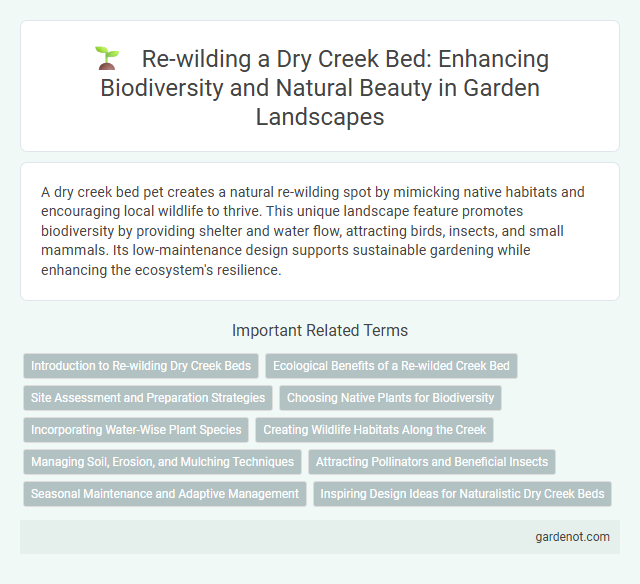A dry creek bed pet creates a natural re-wilding spot by mimicking native habitats and encouraging local wildlife to thrive. This unique landscape feature promotes biodiversity by providing shelter and water flow, attracting birds, insects, and small mammals. Its low-maintenance design supports sustainable gardening while enhancing the ecosystem's resilience.
Introduction to Re-wilding Dry Creek Beds
Re-wilding dry creek beds restores native vegetation and natural water flow, enhancing local biodiversity and ecosystem resilience. These efforts promote habitat connectivity for wildlife, improve soil health, and reduce erosion by reestablishing native grasses, shrubs, and trees. Re-wilding initiatives also support groundwater recharge and create microhabitats essential for amphibians, insects, and small mammals.
Ecological Benefits of a Re-wilded Creek Bed
A re-wilded dry creek bed restores natural habitats by supporting native flora and fauna, increasing biodiversity and enhancing ecosystem resilience. It facilitates groundwater recharge and improves water quality by filtering pollutants and reducing erosion. These ecological benefits contribute to a balanced environment, promoting sustainable wildlife corridors and strengthening climate adaptation efforts.
Site Assessment and Preparation Strategies
Effective site assessment and preparation for re-wilding a dry creek bed involve analyzing soil composition, hydrology, and existing vegetation to ensure suitability for native species restoration. Removing invasive plants and debris while enhancing soil permeability promotes natural water flow and supports biodiversity. Implementing erosion control measures and minimal disturbance strategies preserves the creek bed's ecological integrity during the re-wilding process.
Choosing Native Plants for Biodiversity
Selecting native plants for a dry creek bed enhances local biodiversity by supporting indigenous wildlife and maintaining ecological balance. Native species like purple coneflower, switchgrass, and black-eyed Susan are drought-tolerant and adapted to local soil conditions, ensuring resilience and minimal maintenance. Incorporating diverse native flora creates habitat complexity, promotes pollinator health, and stabilizes the soil naturally, fostering a thriving re-wilding environment.
Incorporating Water-Wise Plant Species
Incorporating water-wise plant species in a dry creek bed enhances ecological resilience by reducing water consumption and improving soil stability. Native drought-tolerant plants such as California fescue, desert willow, and sagebrush promote biodiversity while thriving in arid conditions. These species support local wildlife habitats and contribute to efficient water management in re-wilding projects.
Creating Wildlife Habitats Along the Creek
Restoring native vegetation along the dry creek bed enhances biodiversity by providing essential shelter and food sources for local wildlife species. Strategic placement of logs, rocks, and native plant clusters creates microhabitats that support amphibians, birds, and small mammals. Continuous habitat connectivity encourages natural wildlife movement and improves ecosystem resilience in the re-wilding area.
Managing Soil, Erosion, and Mulching Techniques
Effective re-wilding of a dry creek bed involves strategic soil management to restore natural hydrology and promote native vegetation growth. Implementing erosion control methods such as installing check dams, planting deep-rooted species, and using biodegradable mulches helps stabilize the soil and reduce sediment runoff. Mulching with organic materials like wood chips or straw enhances moisture retention, inhibits weed growth, and improves soil structure, supporting ecosystem resilience.
Attracting Pollinators and Beneficial Insects
Re-wilding a dry creek bed creates an ideal habitat to attract pollinators like native bees, butterflies, and beneficial insects such as ladybugs and lacewings. Planting diverse native flowering species including milkweed, coneflowers, and asters provides nectar and pollen sources essential for pollinator health and reproduction. Incorporating structural features like rocks, logs, and bare soil patches supports nesting and shelter, enhancing biodiversity and ecosystem resilience.
Seasonal Maintenance and Adaptive Management
Seasonal maintenance in dry creek bed re-wilding spots involves controlled vegetation trimming and debris removal to prevent erosion and promote native plant growth. Adaptive management incorporates regular monitoring of hydrological patterns and soil conditions, enabling adjustments to planting schedules and species selection for optimal ecosystem resilience. Implementing these strategies supports biodiversity recovery and enhances natural water filtration throughout varying seasons.
Inspiring Design Ideas for Naturalistic Dry Creek Beds
Naturalistic dry creek beds enhance landscape resilience by mimicking natural water flow and supporting local biodiversity. Incorporating native drought-tolerant plants, river rocks, and varying textures creates an authentic, low-maintenance feature that promotes sustainable water management. Design elements such as gently sloping banks, layered stone arrangements, and seasonal foliage shifts inspire eco-friendly, visually appealing outdoor spaces.
Re-wilding spot Infographic

 gardenot.com
gardenot.com